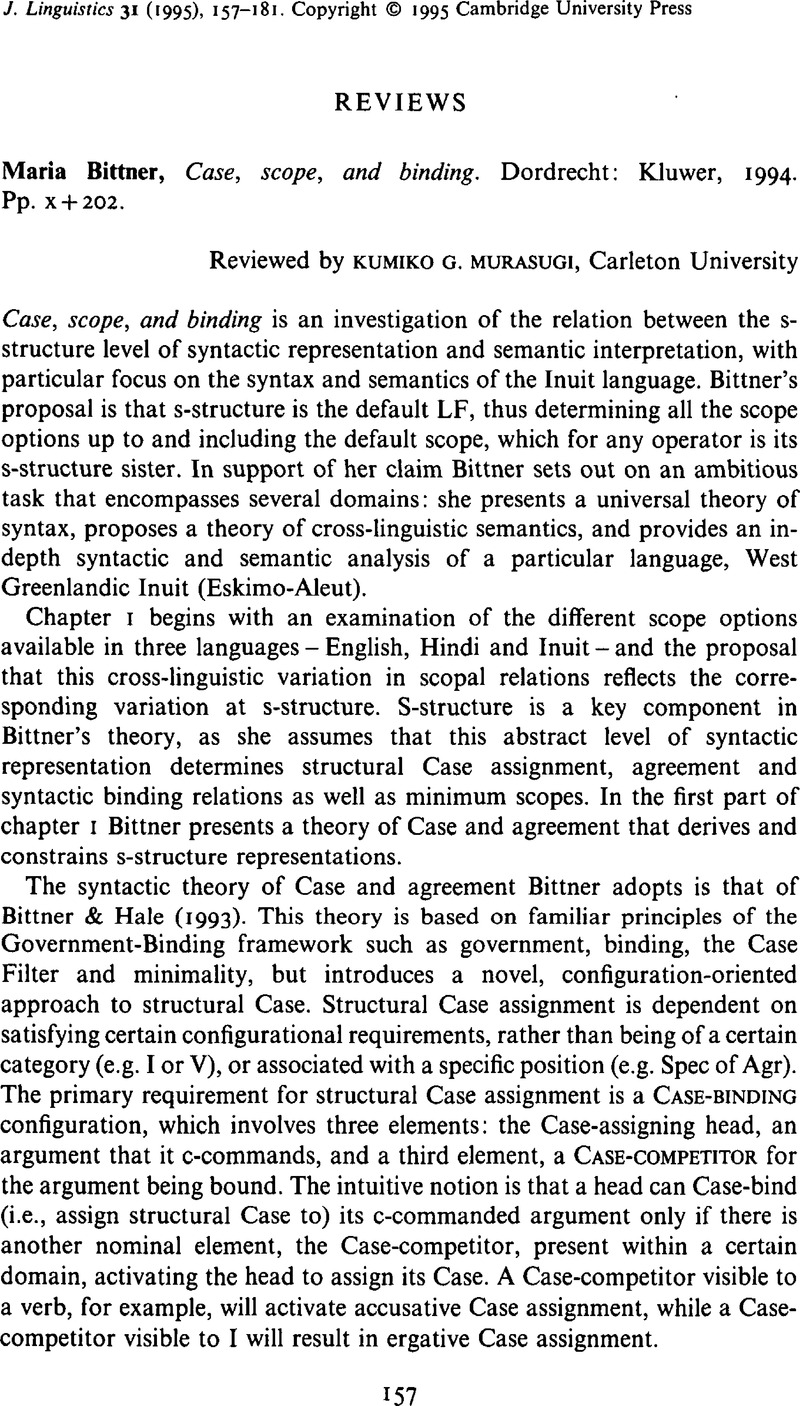No CrossRef data available.
Article contents
Maria Bittner, Case, scope, and binding. Dordrecht: Kluwer, 1994. Pp. x + 202.
Published online by Cambridge University Press: 28 November 2008
Abstract
An abstract is not available for this content so a preview has been provided. Please use the Get access link above for information on how to access this content.

- Type
- Reviews
- Information
- Copyright
- Copyright © Cambridge University Press 1995
References
REFERENCES
Bittner, M. (1994). Cross-linguistic semantics. Linguistics and Philosophy 17. 53–108.CrossRefGoogle Scholar
Bittner, M. & Hale, K. (1993). Ergativity: towards a theory of heterogeneous class. Ms., Rutgers & MIT.Google Scholar
Bittner, M. & Hale, K. (1994). The structural determination of Case. Ms., Rutgers & MIT.Google Scholar
Bobalijk, J. D. (1992). Nominally absolutive is not absolutely nominative. In Mead, J. (ed.) Proceedings of the Eleventh West Coast Conference on Formal Linguistics. Stanford: CSLI. 44–60.Google Scholar
Bok-Bennema, R. (1991). Case and agreement in Inuit. Ph.D. dissertation, de Katholieke Universiteit Brabant.CrossRefGoogle Scholar
Campana, M. (1992). A movement theory of ergativity. Ph.D. dissertation, McGill University.Google Scholar
Johns, A. (1987). Transitivity and grammatical relations in Inuktitut. Ph.D. dissertation, University of Ottawa.Google Scholar
Klein, E. & Sag, I. (1985). Type-driven translation. Linguistics and Philosophy 8. 163–197.Google Scholar
Levin, B. & Massam, D. (1985). Surface ergativity: case/theta relation reexamined. In Berman, S., Choe, J.-W. & McDonough, J. (eds.) Proceedings of the Fifteenth Annual Meeting of the North Eastern Linguistic Society. Amherst, MA: GLSA, University of Massachusetts. 286–301.Google Scholar
Link, G. (1983). The logical analysis of plurals and mass terms: a lattice-theoretic approach. In Bäuerle, R., Schwarze, C. & von Stechow, A. (eds.) Meaning, use, and interpretation of language. Berlin: Walter de Gruyter. 302–323.Google Scholar
Marantz, A. (1991). Case and licensing. In Proceedings of the East Coast Conference on Linguistics. The Ohio State University. 234–253.Google Scholar
Montague, R. (1973). The proper treatment of quantification in ordinary English. In Thomason, R. (ed.) Formal philosophy. New Haven: Yale University Press. 247–270.Google Scholar
Murasugi, K. G. (1992). Crossing and nested paths: NP movement in accusative and ergative languages. Ph.D. dissertation, MIT.Google Scholar
Murasugi, K. G. (1994). Shortest movement and nested paths. Ms., Carleton University, Ottawa.Google Scholar
Partee, B. & Rooth, M. (1983). Generalized conjunction and type ambiguity. In Bäuerle, R., Schwarze, C. & von Stechow, A. (eds), Meaning, use, and interpretation of language. Berlin: Walter de Gruyter. 361–383.Google Scholar
Rischel, J. (1971). Some characteristics of noun phrases in West Greenlandic. Acta Linguistica Hafniensia 13. 213–245.Google Scholar
Sadock, J. (1985). Autolexical syntax: a proposal for the treatment of noun incorporation. Natural Language and Linguistic Theory 3. 379–439.CrossRefGoogle Scholar
Smith, L. (1984). On the nonergativity and intransitivity of relative clauses in Labrador Inuttut. In Cook, E. D. & Gerdts, D. B. (eds). Syntax and semantics 16: The syntax of native American languages. New York: Academic Press. 289–315.Google Scholar
Woodbury, A. (1977). Greenlandic Eskimo, ergativity and relational grammar. In Cole, P. & Sadock, J. (eds.) Syntax and semantics 8: Grammatical relations. New York: Academic Press. 307–336.CrossRefGoogle Scholar
Woodbury, A. (1985). Noun phrase, nominal sentence and clause in Central Alaskan Yupik Eskimo. In Nichols, J. & Woodbury, A. (eds.) Grammar inside and outside the clause. Cambridge: Cambridge University Press. 61–88.Google Scholar


